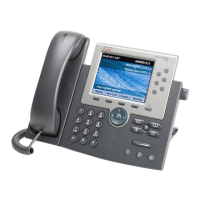4-27
Cisco Unified IP Phone 7965G and 7945G Administration Guide for Cisco Unified Communications Manager 6.1(3)
OL-17755-01
Chapter 4 Configuring Settings on the Cisco Unified IP Phone
Device Configuration Menu
Network Configuration
The Network Configuration menu displays device-specific network configuration settings on the phone.
Table 4-18 describes the options in this menu.
Note The phone also has a Network Configuration menu that you access directly from the Settings menu. For
information about the options on that menu, see the “Network Configuration Menu” section on page 4-5.
Ta b l e 4-18 Network Configuration Menu Options
Option Description To Change
Load Server Used to optimize installation time for phone firmware
upgrades and offload the WAN by storing images
locally, negating the need to traverse the WAN link for
each phone's upgrade.
You can set the Load Server to another TFTP server IP
address or name (other than the TFTP Server 1 or TFTP
Server 2) from which the phone firmware can be
retrieved for phone upgrades. When the Load Server
option is set, the phone contacts the designated server
for the firmware upgrade.
Note The Load Server option allows you to specify
an alternate TFTP server for phone upgrades
only. The phone continues to use TFTP Server
1 or TFTP Server 2 to obtain configuration
files. The Load Server option does not provide
management of the process and of the files,
such as file transfer, compression, or deletion.
From Cisco Unified Communications
Manager Administration, choose
Device > Phone > Phone
Configuration.
RTP Control
Protocol
Indicates whether the phone supports the Real-Time
Control Protocol (RTCP). Settings include:
• Enabled
• Disabled—default
If this feature is disabled, several call statistic values
display as 0. For additional information, see the
following sections:
• Call Statistics Screen, page 7-10
• Streaming Statistics, page 8-11
From Cisco Unified Communications
Manager Administration, choose
Device > Phone > Phone
Configuration.

